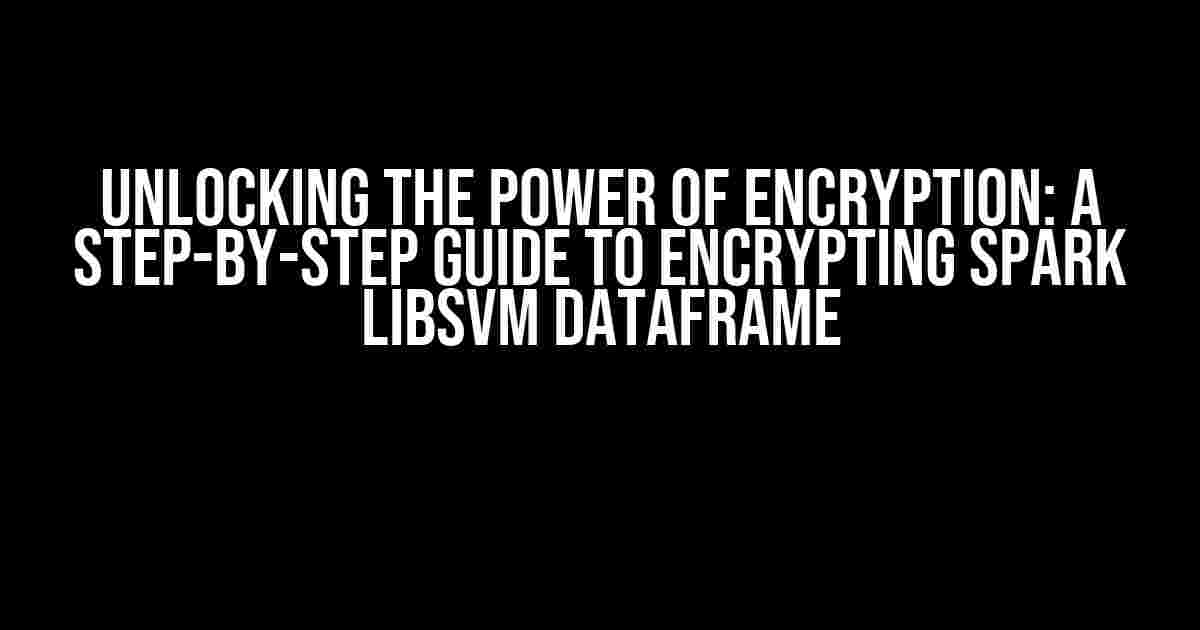As data scientists, we’re no strangers to the importance of data security. With the rise of big data, it’s become more crucial than ever to protect sensitive information from prying eyes. In this article, we’ll delve into the world of encryption and explore how to encrypt Spark Libsvm Dataframe, a crucial step in safeguarding your data.
What is Encryption?
Before we dive into the nitty-gritty of encrypting Spark Libsvm Dataframe, let’s cover the basics. Encryption is the process of converting plaintext data into unreadable ciphertext, making it inaccessible to unauthorized parties. This ensures that even if your data falls into the wrong hands, the information remains confidential.
Why Encrypt Spark Libsvm Dataframe?
Spark Libsvm Dataframe is a powerful tool for data analysis, but it’s not immune to security threats. Encrypting your Libsvm Dataframe adds an extra layer of protection, ensuring that sensitive information, such as:
- Customer data
- Financial records
- Research findings
remains confidential. Moreover, encryption helps comply with regulatory requirements, such as GDPR and HIPAA, which mandate the protection of sensitive data.
Prerequisites
Before we begin, make sure you have the following installed:
- Apache Spark 2.3 or later
- Python 3.6 or later
- Libsvm library
Step 1: Install Required Libraries
To encrypt your Libsvm Dataframe, you’ll need to install the following libraries:
pip install pyspark pip install libsvm-python pip install cryptography
Step 2: Load Your Libsvm Dataframe
Load your Libsvm Dataframe using the following code:
from pyspark.ml.linalg import Vectors
from pyspark.sql import SparkSession
spark = SparkSession.builder.appName("Encrypt Libsvm Dataframe").getOrCreate()
# Load your Libsvm data
data = spark.read.format("libsvm").load("data.libsvm")
Step 3: Generate Encryption Key
Generate a secret key using the cryptography library:
from cryptography.fernet import Fernet
key = Fernet.generate_key()
print("Secret Key:", key.decode())
Step 4: Encrypt Your Libsvm Dataframe
Use the generated key to encrypt your Libsvm Dataframe:
from pyspark.sql.functions import col, udf
# Define an encryption UDF
encrypt_udf = udf(lambda x: Fernet(key).encrypt(x.encode()), returnType=StringType())
# Encrypt your Libsvm Dataframe
encrypted_data = data.select([encrypt_udf(col features).alias("features")])
Step 5: Decrypt Your Libsvm Dataframe (Optional)
If you need to decrypt your Libsvm Dataframe, use the following code:
decrypt_udf = udf(lambda x: Fernet(key).decrypt(x).decode(), returnType=StringType())
decrypted_data = encrypted_data.select([decrypt_udf(col features).alias("features")])
Best Practices and Considerations
When encrypting your Libsvm Dataframe, keep in mind:
- Store your secret key securely, ideally in a Hardware Security Module (HSM) or a secure key management system.
- Use a secure encryption algorithm, such as AES-256.
- Ensure that your Spark cluster is configured with secure communication protocols, such as SSL/TLS.
- Regularly update and patch your Spark and Libsvm libraries to prevent vulnerabilities.
Conclusion
By following this step-by-step guide, you’ve successfully encrypted your Spark Libsvm Dataframe, protecting your sensitive data from unauthorized access. Remember to adhere to best practices and stay vigilant in maintaining the security of your encrypted data. With encryption, you can rest assured that your data is safe and confidential.
| Resource | Link |
|---|---|
| Apache Spark Documentation | https://spark.apache.org/docs/latest/ |
| Libsvm Library | https://www.csie.ntu.edu.tw/~cjlin/libsvm/ |
| Cryptography Library | https://cryptography.io/en/latest/ |
Stay secure, and happy encrypting!
Note: This article is for educational purposes only and should not be considered as professional advice. Always consult with a security expert before implementing encryption in production environments.
Frequently Asked Question
Wondering how to encrypt your Spark Libsvm Dataframe? We’ve got you covered! Check out these FAQs to get started.
What is Libsvm Dataframe in Spark?
Libsvm Dataframe in Spark is a Dataframe that stores data in the Libsvm format, which is a widely used format for machine learning models. It’s essentially a tabular representation of data that can be easily processed and analyzed using Spark’s machine learning libraries.
Why do I need to encrypt my Libsvm Dataframe?
Encrypting your Libsvm Dataframe is crucial because it contains sensitive information that could be exploited by unauthorized parties. By encrypting your data, you ensure that even if it falls into the wrong hands, it will be unreadable and unusable. This is especially important when dealing with sensitive data like personal identifiable information, financial data, or confidential business information.
How do I encrypt my Libsvm Dataframe in Spark?
You can encrypt your Libsvm Dataframe in Spark using various methods, including SSL/TLS encryption, column-level encryption, or full-disk encryption. One popular approach is to use Spark’s built-in encryption features, such as the `encrypt` function, which allows you to encrypt specific columns or entire Dataframes using algorithms like AES.
What are some popular encryption algorithms for Libsvm Dataframes?
Some popular encryption algorithms for Libsvm Dataframes include AES (Advanced Encryption Standard), RSA (Rivest-Shamir-Adleman), and PGP (Pretty Good Privacy). AES is a widely used and highly secure algorithm, making it a popular choice for encrypting Libsvm Dataframes.
Can I decrypt my encrypted Libsvm Dataframe in Spark?
Yes, you can decrypt your encrypted Libsvm Dataframe in Spark using the corresponding decryption keys or algorithms. Spark provides built-in decryption functions, such as the `decrypt` function, which allows you to decrypt encrypted Dataframes and columns. Just make sure to store your decryption keys securely to prevent unauthorized access.

